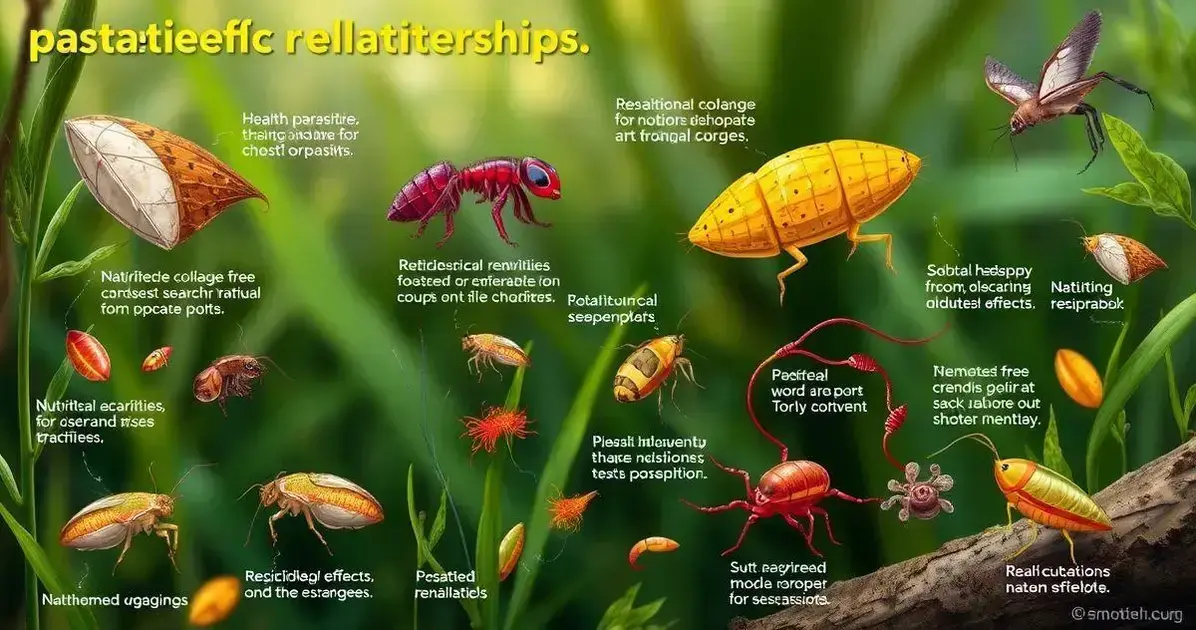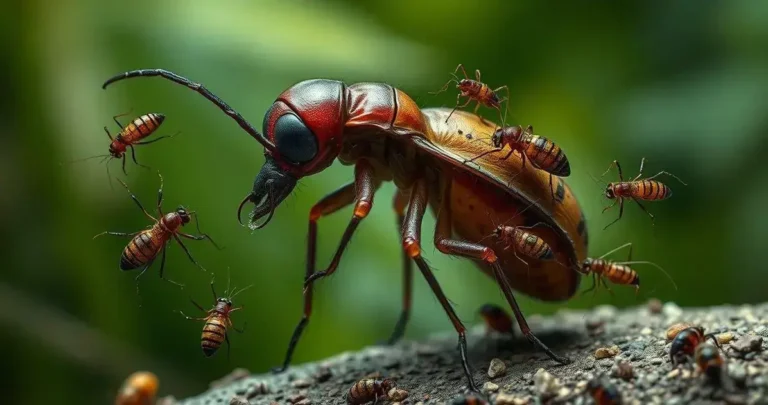Announcements
A parasitic relationship is a one-sided deal where one organism thrives while the other pays the price. It’s a survival tactic seen across nature, from tiny microbes to larger creatures.
Some parasites steal nutrients, others manipulate behavior, and a few take complete control. Their impact can be subtle or devastating, reshaping entire ecosystems.
Curious to know how these relationships work and why they matter? Let’s explore the fascinating world of parasitism.
Announcements
Understanding Parasitic Relationships
Understanding parasitic relationships is essential for grasping how various species interact in nature. In this relationship, one organism, the parasite, benefits at the expense of another organism, the host. This interaction can occur in multiple forms, and learning how they work can reveal much about the complexity of ecosystems.
The Nature of Parasitic Relationships
A parasitic relationship is characterized by the parasite depending on the host for nourishment, shelter, or reproduction. The parasite thrives while the host may suffer adverse effects. Some parasites can cause diseases, weaken their hosts, or even lead to death.
Announcements
Examples of Parasitism
Consider the well-known examples like tapeworms living in the intestines of animals. The tapeworm absorbs nutrients that would typically sustain the host, impacting its health over time. Another example is the relationship between mistletoe and trees, where the mistletoe draws water and nutrients from the host tree, weakening it.
Why Study Parasitic Relationships?
Studying these relationships is vital as it helps scientists understand biodiversity and ecosystem functioning. Parasitism can influence population dynamics and species interactions within an environment, showcasing the delicate balance that exists in nature.
Continuing Research and Implications
Ongoing research into parasitic relationships helps identify new species and understand their impacts on health and ecosystems. This knowledge can lead to improved medical treatments and strategies for managing ecosystems affected by invasive parasites.
Types of Parasitic Relationships
There are several types of parasitic relationships in nature, and each type has its unique characteristics and examples. Understanding these categories helps us better grasp how parasites interact with their hosts.
1. Ectoparasites
Ectoparasites live on the outside of their hosts. Common examples include fleas, ticks, and lice. These parasites attach themselves to the skin or fur of the host, feeding on blood or tissue. Ectoparasites can cause irritation, transmit diseases, and weaken their hosts over time.
2. Endoparasites
Endoparasites reside within the host’s body, often in the intestines or other organs. Examples include tapeworms and roundworms. These parasites absorb nutrients directly from the host’s body, which can lead to malnutrition and other health problems for the host.
3. Faculative Parasites
Facultative parasites can live both as parasites and as free-living organisms. An example is the amoeba that can cause diseases in humans but can also survive in soil. These parasites switch between lifestyles based on environmental conditions and availability of hosts.
4. Obligate Parasites
Obligate parasites require a host to complete their life cycle. They depend entirely on their host for survival and cannot live outside of it. Examples include some species of viruses and certain bacteria that infect animals and plants.
5. Social Parasites
Social parasites exploit the social behavior of hosts. For instance, some bird species lay their eggs in the nests of other birds, tricking them into raising their young. This relationship can be highly deceptive and manipulative.
Effects on Host Organisms

The effects on host organisms can vary significantly based on the type and severity of the parasitic relationship. Understanding these effects is crucial for grasping how parasitism influences ecosystem dynamics.
Health Impacts
Parasites can lead to various health issues for their hosts. They may cause diseases that weaken the immune system, leaving the host vulnerable to additional infections. For example, infected animals may exhibit symptoms like fatigue, weight loss, and poor growth, affecting their overall well-being.
Nutrient Deprivation
One of the most significant effects of parasites is nutrient depletion. Endoparasites, like tapeworms, absorb essential nutrients from the host’s diet. This can result in malnutrition, particularly in younger or weaker hosts who already struggle to obtain sufficient food.
Behavioral Changes
Some parasites induce behavioral changes in their hosts to benefit their life cycle. For example, certain parasites may cause infected animals to seek out predators, ensuring their own spread. This manipulation can drastically affect the host’s natural behavior, putting them at risk.
Physical Damage
Parasites can also cause direct physical harm to their hosts. Ectoparasites like fleas and ticks can inflict painful bites, leading to skin infections and other complications. Endoparasites may cause internal damage, such as inflammation or blockage in organs.
Reproductive Impact
Parasites frequently affect the reproductive success of their hosts. For example, a heavily infested host may have reduced reproductive capabilities. Some parasites can even manipulate the reproductive systems of their hosts to create more opportunities for themselves.
Case Studies of Parasitic Relationships
Examining case studies of parasitic relationships helps illustrate how these interactions work in real-world environments. Here are a few notable examples:
1. The Green Band-Winged Orchid and the Bumblebee
The green band-winged orchid relies on bumblebees for pollination. The orchid produces a scent that mimics the female bumblebee, attracting male bees. While the bee is tricked into attempting to mate, it inadvertently collects pollen and spreads it to other orchids. This relationship is a fascinating example of how plants can manipulate animal behavior to ensure their reproduction.
2. Cuckoo Birds and Their Hosts
Cuckoo birds are known for their brood parasitism. They lay their eggs in the nests of other bird species, like warblers. The unsuspecting host birds raise the cuckoo chick, often at the expense of their own eggs. This case study shows how parasitism can lead to manipulation and deception in animal behavior.
3. Tapeworms in Mammals
Tapeworms are endoparasites that infect the intestines of various mammals, including humans. They consume nutrients from the host’s diet, often leading to malnutrition. In some cases, heavy infestations can cause intestinal blockages or other severe complications. This case study highlights the significant impact parasites can have on host health.
4. Malaria Parasite and Mosquitoes
The malaria parasite, transmitted by Anopheles mosquitoes, is a well-known case of parasitism. The parasite lives in the mosquito’s saliva and is injected into humans when the mosquito bites. This not only harms the human host but also affects the mosquito population’s dynamics as it relies on human hosts for reproduction.
5. The Cleaner Wrasse and Client Fish
Cleaner wrasse fish clean the parasites off larger fish, creating a mutualistic relationship where both species benefit. However, some wrasse fish take advantage of their clients by eating their scales instead of cleaning them. This shows that parasitism can exist even within seemingly beneficial interactions.
The Role of Parasitism in Ecosystems
The role of parasitism in ecosystems is complex and vital for maintaining the balance of various habitats. Parasitism affects species interactions, population dynamics, and even ecosystem health.
1. Population Control
Parasites help regulate host populations by keeping them in check. For example, a high number of parasites may reduce the population of their host species. This can prevent overpopulation, which in turn supports a balanced ecosystem where resources are not depleted.
2. Biodiversity
Parasitism contributes to biodiversity, as it creates different niches within ecosystems. Different parasites target specific host species, which can lead to diverse interactions. This variety can increase overall ecosystem resilience, allowing it to adapt to changes in environmental conditions.
3. Energy Transfer
Parasites play a role in energy transfer within ecosystems. By consuming nutrients from their hosts, parasites can influence energy flow through food webs. This interaction can affect larger predators that feed on infected hosts, impacting the entire ecosystem structure.
4. Evolutionary Pressure
Parasitism is a driving force behind evolutionary adaptations. Hosts often develop defenses, such as stronger immune systems or behavioral changes, to combat parasites. This evolutionary arms race can promote genetic diversity within species, ultimately enhancing survival strategies in changing environments.
5. Nutrient Cycling
When parasites die or their hosts die, they release nutrients back into the environment. This process contributes to nutrient cycling, enriching the soil and supporting plant growth. Healthy plant life ensures the sustainability of the ecosystem, demonstrating how parasitism can have far-reaching effects.
FAQ – Frequently Asked Questions about Parasitic Relationships
What is a parasitic relationship?
A parasitic relationship is an interaction where one organism, the parasite, benefits at the expense of another organism, the host.
What are the different types of parasitic relationships?
The main types include ectoparasites, endoparasites, facultative parasites, obligate parasites, and social parasites.
How do parasites affect their host organisms?
Parasites can cause health problems, nutrient depletion, behavioral changes, physical damage, and reproductive impacts for their hosts.
Can you give examples of parasitic relationships?
Examples include cuckoo birds laying eggs in other bird nests, tapeworms living in mammal intestines, and cleaner wrasse fish eating scales instead of cleaning.
What role does parasitism play in ecosystems?
Parasitism can help regulate populations, increase biodiversity, influence energy transfer, drive evolutionary adaptations, and aid in nutrient cycling.
Are all parasites harmful to their hosts?
Not all parasites are harmful in the same way; some can have minimal effects while others can severely impact host health and survival.






